|
 Austropaxillus nothofagi Austropaxillus nothofagi
SynonymsPaxillus nothofagi
BiostatusPresent in region - Indigenous. Endemic
Images (click to enlarge)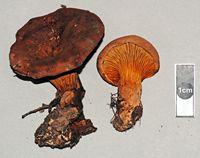
Owner: J.A. Cooper | 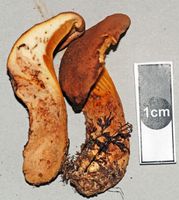
Owner: J.A. Cooper | 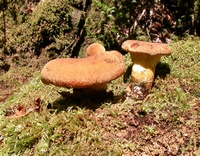
Owner: P. Leonard | 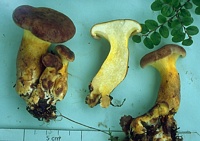
Owner: Karl Soop | 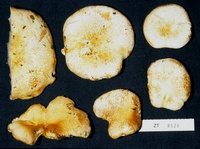
Caption: ZT8526
Owner: E. Horak: © Creative Commons Attribution-Noncommercial 3.0 New Zealand | 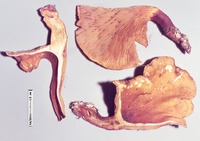
Caption: ZT68-244
Owner: E. Horak: © Creative Commons Attribution-Noncommercial 3.0 New Zealand | 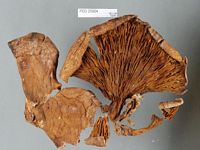
Caption: Dried type specimen
Owner: Herb PDD | 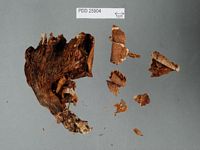
Caption: Dried type specimen
Owner: Herb PDD | 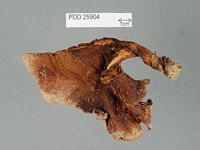
Caption: Dried type specimen
Owner: Herb PDD | 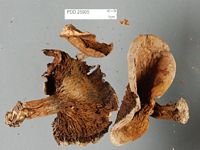
Caption: Dried type specimen
Owner: Herb PDD | 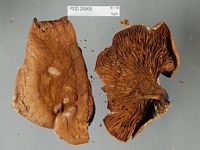
Caption: Dried type specimen
Owner: Herb PDD | 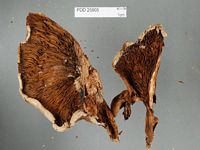
Caption: Dried type specimen
Owner: Herb PDD | 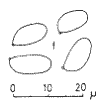
Caption: Paxillus nothofagi: spores | 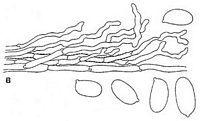
Caption: McNabb (ZT 68/244): spores, cuticle. | 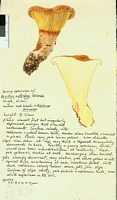
Caption: Watercolour
Owner: G.M. Taylor |
Article: McNabb, R.F.R. (1969). The Paxillaceae of New Zealand. New Zealand Journal of Botany 7(4): 349-362 (http://www.rsnz.org/publish/abstracts.php).
Description: PILEUS: convex when young, infundibuliform or irregularly infundibuliform at
maturity, 6-18 cm diam., dry, velutinate, finely felted, or subtomentose, often
circumferentially creviced and exposing the bright yellow context at maturity,
bronze, oak brown, cinnamon brown, or cocoa brown; cuticle a trichodermium when
young, composed of erect, filamentous hyphae with conspicuous clamp connections
and brown contents, terminal cells cylindrical to subclavate, thin-walled or
slightly thick-walled, often externally roughened, 7-15 µm. diam., becoming
disorganised at maturity; margins strongly involute when young, irregularly
involute and often undulate and irregularly lobed at maturity. LAMELLAE: crowded,
deeply decurrent, repeatedly dichotomously branched 4-(6) times, occasionally
anastomosing, thick, 4-8 mm deep, maize yellow to amber yellow, often spotted
and stained dark reddish brown at maturity, lamellulae absent. STIPE: 2-7 cm
long, subequal or tapering basally, 1-2.5 cm diam. apically, 1-2 cm diam. basally,
central or occasionally eccentric, solid, dry, finely velutinate, felted, or
subtomentose by presence of filamentous, clamped hyphae with dark brown contents,
concolorous with pileus; flesh brownish white to yellowish white, unchanging
on exposure to air; veil absent.
SPORES: spore print orange-brown (between Sudan Brown and Antique Brown); spores
golden-melleous to bright rusty brown, elliptical, broadly elliptical, or ovate
and flattened on one side, minutely apiculate, germ pore absent, 7.8-11 X 4.5-5.8-(6.8)
µm., moderately thick-walled, smooth. HYMENIUM: basidia hyaline, subclavate,
38-58 X 6.5-9.5 µm., (2)-4-spored: cystidia absent but numerous sterile, paraphysis-like
structures present. HYMENOPHORAL TRAMA: bilateral, mediostratum of loosely interwoven
hyphae and occasionally oleiferous hyphae, lateral stratum of more closely interwoven
hyphae; clamp connections present. CONTEXT OF PILEUS: yellowish white, un-changing
on exposure to air. SMELL: not distinctive. TASTE: bitter. CHEMICAL CHARACTERS:
KOH on pileus—dark reddish brown; on context—salmon; NH4OH on pileus—dark reddish
brown with red flush; on context—pallid salmon.
Habitat: HABITAT: Gregarious or caespitose under Nothofagus.
Notes: Of the sections of Paxillus distinguished by Singer (1962), P. nothofagi
fits most readily within sect. Veluticipites. The major point of disagreement
between P. nothofagi and Singer's sectional diagnosis is in spore length,
but this is possibly not of great importance, since the section is based on
a single Australian species, P. veluticeps (Cooke & Mass.) Singer.
The spores of P. veluticeps measure 13-18.3 X 4.5-6.3µm. and are considerably
longer than those of P. nothofagi. As in sect. Defibulati, the
two species admitted to sect. Veluticipites are both of south temperate
distribution.
The strict association of P. nothofagi with Nothofagus suggests
that it is a mycorrhizal species. It may be distinguished from P. squarrosus
and P. aurantiacus by the larger fruitbodies, smaller elliptical spores,
and the presence of clamp connections.
Article: Horak, E. (1980) [1979]. Paxilloid Agaricales in Australasia. Sydowia 32: 154-166.
Notes: The elliptic spores distinctly separate P. nothofagi from the two other native New Zealand species of Paxillus. Size and shape of the spores remind of those in P. involutus (Fr.) which, however, is readily distinguished by the presence of large cystidia.
|